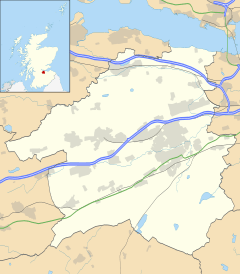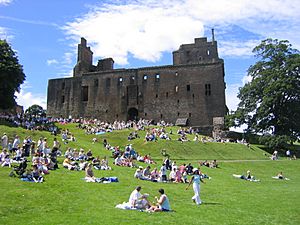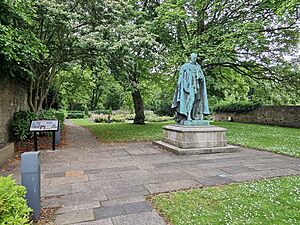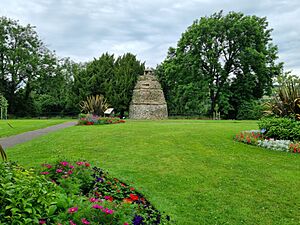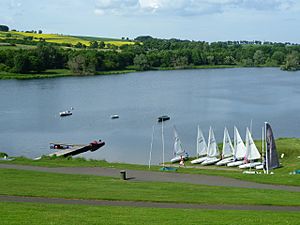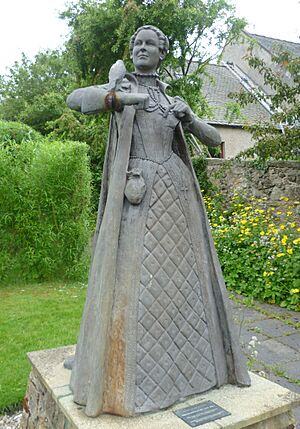Linlithgow facts for kids
Quick facts for kids Linlithgow
|
|
|---|---|
| Town | |
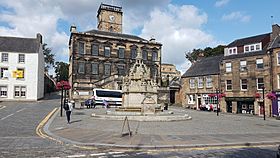 Linlithgow Town Centre, showing the Burgh Halls (background) and the Cross Well (foreground), August 2018 |
|
| Population | 12,840 (2020) |
| OS grid reference | NS996774 |
| Council area | |
| Lieutenancy area | |
| Country | Scotland |
| Sovereign state | United Kingdom |
| Post town | LINLITHGOW |
| Postcode district | EH49 |
| Dialling code | 01506 |
| Police | Lothian and Borders |
| Fire | Lothian and Borders |
| Ambulance | Scottish |
| EU Parliament | Scotland |
| UK Parliament |
|
| Scottish Parliament |
|
Linlithgow is a historic town in West Lothian, Scotland. It used to be the main town of the West Lothian area, which was even called Linlithgowshire back then. This old town is located in the Central Belt of Scotland. It sits on an important old road that connects Edinburgh and Falkirk, right next to Linlithgow Loch. The town is about 20 miles (32 km) west of Edinburgh.
In the Middle Ages, Linlithgow became very important. It was a royal burgh, meaning it had special rights from the king. It was also home to Linlithgow Palace, a royal home. Later, Linlithgow became known for making leather and other goods. It grew even faster in the Victorian era when the Union Canal opened in the 1820s and the railway arrived in 1842.
While Linlithgow was once the main town, the local council now meets in Livingston. Today, Linlithgow has less industry. Its economy mostly focuses on hotels, restaurants, and tourism. The town's special protector is Saint Michael, and its motto is St. Michael is kind to strangers. You can see a statue of Saint Michael holding the town's coat of arms on the High Street. In 2019, the Linlithgow area had about 16,499 people living there.
Contents
Exploring Linlithgow's Past
Linlithgow has a very long and interesting history. Many of its old buildings tell stories of kings, queens, and everyday life.
Linlithgow Palace: A Royal Home
The most famous historical site in Linlithgow is Linlithgow Palace. This palace is where King James V and his daughter, Mary, Queen of Scots, were born. It's one of Scotland's best examples of a late medieval royal building. The palace you see today was started in 1424 by James I of Scotland on an even older site.
Sadly, the palace was burned in 1746. Even though it no longer has a roof, most of its rooms are still standing. Very few of the original royal furniture or decorations survived the fire.
St. Michael's Church: A Unique Spire
Right next to the Palace is the 15th-century St. Michael's Church. Its tall western tower used to have a special stone crown spire, like the ones you can see on St Giles Cathedral in Edinburgh. This old spire was taken down in the early 1800s.
In 1964, a new and modern spire was added. It's made of aluminium and was designed by Scottish architect Sir Basil Spence. This new spire looks like Christ's crown of thorns and is quite unique.
Historic High Street and Town Centre
Many old buildings line Linlithgow's High Street. On the south side, the ground rises, and you can still find narrow old lanes called "wynds" and "closes," similar to those in Edinburgh.
The most important spot in the town centre is the Cross Well, built in 1807. It's a copy of an older well from 1628. North of the well is the Town House, built in 1668 by John Smith. This building replaced an earlier hall that was destroyed by Oliver Cromwell's army in 1650. Much of its inside was changed in 1962 to make it more modern.
Linlithgow's Location and Layout
Linlithgow generally stretches from east to west. It's built around what used to be the main road between Edinburgh and Stirling, which is now called the High Street.
In the past, plots of farmland called "rigs" ran straight out from the High Street. These rigs made up much of the town's early growth. The town's growth was limited to the north by Linlithgow Loch and to the south by a steep hill. However, in the late 1800s and early 1900s, building started to spread further south of the High Street.
Later, in the late 1900s, more homes were built even further south and in new areas. This growth to the south was cut through by the Union Canal and later by the main Edinburgh-Glasgow railway line. Today, there are only three places where you can cross the canal and railway in town, which can cause traffic issues.
To the west, Linlithgow Bridge used to be a separate village. But in the last 50 years, it has become part of the main town, and it's hard to tell where one ends and the other begins.
How Linlithgow is Governed
Linlithgow is part of a larger system of government in Scotland and the United Kingdom.
Representing Linlithgow in the UK Parliament
For the Parliament of the United Kingdom in London, Linlithgow has been part of the Bathgate and Linlithgow area since 2024. This area used to be a safe seat for the Labour Party. However, in 2015, the Scottish National Party (SNP) won the seat. In the 2024 election, Kirsteen Sullivan from the Labour Co-op party became the Member of Parliament (MP).
Linlithgow in the Scottish Parliament
In the Scottish Parliament in Edinburgh, Linlithgow is represented by Fiona Hyslop from the SNP. She is currently in charge of culture, tourism, and external affairs for Scotland. Before 2011, the town was represented by a Labour politician. Linlithgow is also part of a larger voting area called Lothian.
Local Council and Community
At the local level, Linlithgow is represented by councillors on the West Lothian Council. In the 2022 local elections, the Linlithgow area elected one SNP, one Labour, and one Liberal Democrat councillor. For the first time, Linlithgow elected female councillors to the West Lothian Council.
There is also a local group called the Linlithgow and Linlithgow Bridge Community Council. This group helps to represent the local community's views.
Linlithgow's Coat of Arms
The town's coat of arms has an interesting story. It features a black dog chained to an oak tree on an island. This comes from a legend about a loyal dog that swam to its master, who was chained to a tree on an island. The dog brought him food every day. When this was found out, the dog was chained to a tree on a different island. The townspeople saw the dog's loyalty and bravery as a symbol of their own town.
Linlithgow's Economy and Businesses
Linlithgow's long history and central location make it a popular place for tourists to visit. Many people who live here travel to work in Glasgow, Edinburgh, or Stirling. This is easy because of the town's train station and its closeness to the M8 and M9 motorways.
The town has three large supermarkets and a shopping area in Linlithgow Bridge. There are also many different local shops on the High Street. In 2012, there were plans for new shops and homes to the east of town. Many local groups were against these plans. In November 2013, the plans were stopped because they would have changed the town's special character.
Linlithgow is home to a big computing centre owned by Oracle. It also has Calnex Solutions, a telecommunication company that started in the town in 2006.
In the past, Linlithgow had industries like the St. Magdalene's whisky distillery, Nobel explosives factories, paper mills, and many tanneries (places where leather is made). The Regent Centre, now called Nobel House, was built in 1983. It replaced the old Nobel Explosive Company Works Factory from 1908 and now has a small shopping centre with shops and a bank.
Culture and Community Life
Linlithgow has a lively community with many traditions and events throughout the year.
Riding of the Marches
One of the oldest and most colourful events is the Riding of the Marches. It has been celebrated since the mid-1500s and happens on the first Tuesday after the second Thursday in June. This event involves people of all ages checking the town's boundaries, including its historic port of Blackness.
Today, the event is mostly about colourful parades through the town with bands and floats decorated by local groups. However, the more traditional parts of checking the boundaries are still done. Many local groups work hard to keep both the old and new traditions alive.
Festivals and Events
Linlithgow hosts many other events each year. These include the Children's Gala Day, the Linlithgow Folk Festival, and a Victorian Street Fayre before Christmas. Since 2014, there's also "Party at the Palace," a music festival held every August by the loch. Famous bands like Nile Rodgers, Kaiser Chiefs, Travis, Simple Minds, The Proclaimers, and Texas have played there. The Charlatans and Deacon Blue were the main acts in 2019.
Community Groups and Local News
The strong sense of community in Linlithgow is helped by many active local groups. These include Linlithgow Amateur Musical Productions (LAMP), Lithca Lore, the Linlithgow Players, and the 41 Club. The town also has its own weekly local newspaper, the Linlithgow Gazette.
The Linlithgow Union Canal Society runs a canal museum and offers boat tours on narrowboats from the Manse Road basin.
Churches and Hospitals
The town has two Church of Scotland churches: St Michael's and the smaller St. Ninian's Craigmailen. There are also other churches, including a Methodist chapel (now an evangelical church), St Peter's (a unique Scottish Episcopal church), and a Roman Catholic church, also called St Michael's. This Roman Catholic church was used as an ambulance base by Polish soldiers during World War II.
The Linlithgow Museum is run by volunteers and tells the history of the town. It's located in the Linlithgow Partnership Centre, which also has the West Lothian Family History Society and the library.
St Michael's is a local hospital in the town. It started as a poorhouse and infirmary in 1856. A hospital for infectious diseases was built nearby around 1900. These two places joined to become St Michael's Home and Hospital in 1932. The hospital became part of the National Health Service in 1948. The old poorhouse building was taken down in 1969 and replaced with the modern building you see today.
Parks and Green Spaces
Linlithgow has several parks and recreation areas. The largest public space is the Peel and Palace Royal Park, next to Linlithgow Loch and the palace. It has a large open grassy area (the Peel), a path around the Loch, and old trees to the south.
Linlithgow Rose Garden is a beautiful rose garden next to the church graveyard and behind the Burgh Halls. It has a large bronze statue of John Hope, 7th Earl of Hopetoun and Marquess of Linlithgow (made in 1911). Work is being done to improve the rose gardens as of 2021.
Learmonth Gardens are on the south side of the railway, across from the canal basin. They were given to Linlithgow in 1916 to remember Alexander Learmonth, who was the town's leader from 1802 to 1807. A key feature of the gardens is a 16th-century beehive-shaped doocot (a building for pigeons). It has 370 nest boxes and a lantern on top, but you can't go inside.
Rosemount Park is a large open public park in the middle of southern Linlithgow. It has a Friar's Well, which used to provide water for an old Carmelite monastery that was destroyed during the Scottish Reformation. The well is now covered by a stone arch. The park also has several old trees.
Kettlestoun Mains is a woodland path next to the Avon Lagoon, near where the Battle of Linlithgow Bridge once took place. Just outside Linlithgow, there are several country parks. These include Beecraigs Country Park, a large park with forests, a visitor centre, and a loch, and Muiravonside Country Park, with woodlands and grasslands.
Getting Around Linlithgow
Linlithgow is well-connected, making it easy to travel to and from the town.
Train and Motorway Connections
Linlithgow railway station is the main train station. It's on the Glasgow to Edinburgh via Falkirk Line. You can catch trains from here to Edinburgh and Dunblane, and a daily train between Glasgow and the Fife Circle Line. The station first opened on February 21, 1842.
The M9 Motorway runs along the northern edge of the town. This motorway connects Linlithgow to Edinburgh, Stirling, and Falkirk. The main east-west road through the town is the A803 road, which includes Linlithgow's High Street. The main north-south road is the A706 road. The closest airport is Edinburgh Airport.
Bus Services
Linlithgow is served by the McGill's Scotland East bus service X38. This bus goes between Edinburgh and Falkirk, passing through Corstorphine, Kirkliston, and Winchburgh.
Education in Linlithgow
Linlithgow has schools for all ages, from primary to secondary.
Secondary School
Linlithgow has one Secondary school: Linlithgow Academy. The original Linlithgow Academy building was a specially built sandstone building in East Port. It was designed in a Scottish Renaissance style with turrets by James Graham Fairley in 1900. The Academy moved to a new school on Braehead Road in 1968, in the south-west of the town. The old academy building is now home to Low Port Primary School.
Primary Schools
The town has five primary schools: Linlithgow Primary School, St Joseph's RC Primary School, Linlithgow Bridge Primary School, Low Port Primary School, and Springfield Primary School.
Donaldson's School
Donaldson's School, which is Scotland's national school for deaf children, is located in Linlithgow. It moved from Edinburgh to a new campus called the Sensational Learning Centre in 2008. This school was built where an old electronics factory used to be.
Linlithgow does not have its own college. The closest colleges are West Lothian College in Livingston and Forth Valley College in Falkirk.
Sports and Recreation
Linlithgow offers many opportunities for sports and outdoor activities.
Football and Rugby
Linlithgow Rose Community Football Club is a large club with about 500 players. They are involved in different types of football, including youth and adult teams. The club also has a special school for goalkeepers and a referee training program.
Linlithgow is also home to Linlithgow Rose F.C., Linlithgow Rugby Football Club, and Linlithgow Cricket Club. The cricket club plays at the Boghall Cricket Club Ground.
The town also has two official Scotland Supporters Clubs for the Scottish National football team: Linlithgow & District Tartan Army (LADTA) and the Young Linlithgow Tartan Army (YLTA).
Parks and Outdoor Centres
Many local parks with play areas for children are located throughout the town. The large area of land around the palace, known as the Peel, is very popular in summer. Low Port Outdoor Education Centre is right next to Linlithgow Loch. It provides facilities for many outdoor activities, especially those on the loch. Nearby country parks include Beecraigs and Muiravonside.
Golf and Speedway
Linlithgow golf club, which started in 1913, is located south of the canal on the western edge of town.
Motorcycle speedway races used to take place at the Heathersfield Stadium. This stadium was used for training until 1994, when a team called Linlithgow Lightning joined a racing league. The team raced until the end of the 1999 season.
Famous People from Linlithgow
Linlithgow has been the birthplace or home of several notable people throughout history.
Royalty
Two famous Scottish monarchs were born in Linlithgow Palace: King James V, born in 1512, and his daughter, Mary, Queen of Scots, born and christened in Linlithgow in 1542.
Scientists and Business Leaders
Important figures in science and industry from Linlithgow include Sir Charles Wyville Thomson, a natural historian and marine zoologist who was the chief scientist on the Challenger Expedition. John West (1809–1888) was a Scottish inventor and businessman who moved to Canada and later Oregon, where he ran a cannery and sold tuna to Great Britain. David Waldie, a local chemist, suggested using chloroform in medicine to Sir James Young Simpson. Sir Thomas Carlaw Martin (1850–1920) was a newspaper editor and a director of the Royal Scottish Museum.
Sports Stars
Sports figures include Colin Fleming, a professional tennis player who grew up and went to school in Linlithgow. Footballer Colin Stein was born in Linlithgow in 1947. Footballer and Cricketer Donald Ford was born in Linlithgow in 1944.
Military and Politics
Notable people in military history and politics include Robert Blair, who received the Victoria Cross for bravery. Alex Salmond, a former First Minister of Scotland, was born in 1954 and grew up in Linlithgow.
Fictional Character
In September 2007, a plaque was put up to remember the fictional Star Trek character Montgomery "Scotty" Scott. According to Star Trek stories, the chief engineer of the Starship Enterprise will be born in Linlithgow in the year 2222.
Twin Towns
Linlithgow has special connections with towns in other countries. It is twinned with the French town of Guyancourt. Also, as part of West Lothian, it is twinned with Grapevine, Texas in the USA. These connections have led to exchange programs where students from Linlithgow visit schools in Grapevine.
Images for kids
See also
 In Spanish: Linlithgow para niños
In Spanish: Linlithgow para niños


